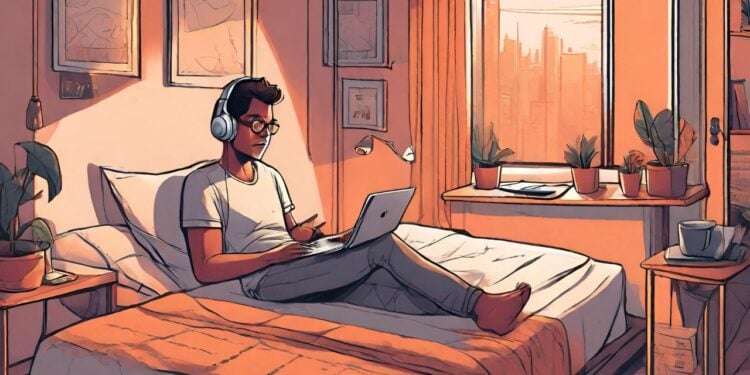- Virtual meetings have changed how we present ourselves to work colleagues, but sometimes the image we project is far from reality.
- Many remote workers have learned to create a facade — concealing the real state of their home offices.
- Unlike in-person meetings, a virtual meeting is an opportunity to present certain aspects of our lives that reveal something personal about us (for example, our book collection or pets). The challenge is maintaining an appropriate balance between our personal and professional lives.
In 2020, a scientist shared the reality of her Zoom background on Twitter. The Tweet went viral and encouraged others working from home during the pandemic to share some truths about remote working.
Recently, the Guardian published an article featuring images of real versus fake virtual backgrounds (based on readers’ photographs depicting both set-ups). These pictures reveal that three years after the pandemic forced many of us to work from home, we are still navigating the not-so-new phenomenon of online meetings.
The Facade Versus the Reality
During the pandemic, we were inundated with images of celebrities and well-known business people being interviewed or attending virtual meetings with perfectly styled backgrounds. These images often showed people seated in front of beautifully polished bookcases housing the “right” type of books, carefully positioned flourishing plants, clean and simple lines, perfect lighting, and soft finishes with an appropriate pop of color. To many of us, these images became the “gold standard” of backgrounds for online meetings. Remote workers tried (some in vain and others with more success) to replicate these “perfect” backgrounds.
Failure to reproduce the ideal backdrop resulted in employees relying on operational functions built into most virtual meeting platforms — such as cameras and blurred or virtual backgrounds. The fact that the camera function used in remote meetings reveals a relatively small area of the overall work-from-home environment was a blessing. When employees do not wish to share certain “messier” aspects of their personal lives (clothing on the floor, cups left on surfaces and pieces of Lego lying around), they can design the space for the camera as they see fit by cleverly concealing those less desirable elements.
Remote workers discovered other advantages of online meeting platforms, such as the “stop video” and “mute” buttons for when children, pets and other unexpected visitors entered their background space. The “stop video” button also serves as a great way to hide from colleagues when people feel under par or are experiencing a particularly bad hair day.
The Guardian published an article in 2020 that depicted one diplomat’s work-from-home reality in contrast to his “professional” Zoom background. The images revealed the diplomat working in his young daughter’s bedroom surrounded by doll houses and pink toys, but the only items visible in his online background were a pair of sleek, white curtains and a bookshelf. The same article also highlighted how the Guardian’s Head of Multimedia had learned the art of “professional reclining” — the ability to project the image of sitting upright when, in reality, you are reclining on a sofa during online meetings.
How Have Remote Workers Learned to Present the Most Professional Image
Prior to the pandemic, those of us who had not previously engaged in remote meetings had only one version of ourselves at home. Today, many workers have learned to inhabit two selves — one that is thoroughly relaxed away from the public eye and the other a more professional version who attends virtual meetings. It is common for people to depict their professional selves as being highly-organized and tidy. This is a skill that remote workers have had to perfect.
At one end of the spectrum, colleagues will turn off the video camera, select a virtual backdrop (from jungle scenes to desert sand dunes and snowy mountain peaks), or blur their background as an alternative to a more professional environment. Then there are those who only dress professionally from the waist up (tracksuit pants and slippers below; shirt, tie and well-groomed hair above the waist).
Remote workers can be very imaginative when preparing for online meetings. One employee used an ironing board and a stack of books to create the perfect stand for an iPad during a Zoom audition. Makeshift desks and different techniques (such as Halo/ring lights) to project expert lighting are just two techniques that remote workers have discovered in their quest to present a professional image on Zoom.
How Should Remote Workers Present Themselves in Zoom Meetings?
Would being more honest about what is happening in our home lives make remote workers appear more relatable, or is it unprofessional to “be real” in online meetings? Are people too afraid, embarrassed or ashamed to reveal their true selves — and, if so, why? It has been reported that remote workers enjoy the appearance of pets in online meetings — specifically dogs. Perhaps we could show off our pets a bit more? Remote workers, however, seem less sure about the appearance of children and significant others in online meetings (Zoom even offers advice on how to keep uninvited guests out of your background).
People want to look professional in online meetings, but that should not preclude remote workers from revealing snippets of their personal lives. The pressure for impressive aesthetics should also not distract people from being good “Zoom communicators.” Remote workers who are at ease with their appearance during online meetings are often more focused on the issues that matter.
Virtual meetings also compel remote workers to pay more attention due to the presence of multiple screens, and therefore, focusing too much on the screen backgrounds of participants who are not talking can make people less likely to play an active role during discussions.
Whatever our issues with online meetings, they are here to stay, so becoming more confident and comfortable with how we present ourselves in virtual meetings is an ability we should all develop.

 Dr. Gleb Tsipursky – The Office Whisperer
Dr. Gleb Tsipursky – The Office Whisperer Nirit Cohen – WorkFutures
Nirit Cohen – WorkFutures Angela Howard – Culture Expert
Angela Howard – Culture Expert Drew Jones – Design & Innovation
Drew Jones – Design & Innovation Jonathan Price – CRE & Flex Expert
Jonathan Price – CRE & Flex Expert












